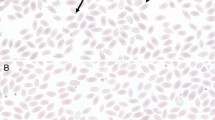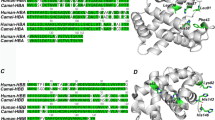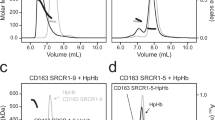Abstract
ALTHOUGH the presence of hæmoglobin in free-living flatworms (Turbellaria) has been recorded by several authors1–4, the pigment has not yet been investigated in detail. A large sample of the rhabdoccel. Phaenocora unipunctata (Orsted 1843), was obtained from mud from Coe Fen, Cambridge. These worms were found to contain hæmoglobin, and a preliminary examination was made of the properties of this pigment and its distribution within the tissues of the animal.
This is a preview of subscription content, access via your institution
Access options
Subscribe to this journal
Receive 51 print issues and online access
$199.00 per year
only $3.90 per issue
Buy this article
- Purchase on SpringerLink
- Instant access to full article PDF
Prices may be subject to local taxes which are calculated during checkout
Similar content being viewed by others
References
Moseley, H. N., Phil. Trans. Roy. Soc., 164, 105 (1874).
Francott, P., Bull. Acad. Belg., Cl. Sci., 6, 723 (1883).
Cuénot, L. (quoted by Prenant, ref. 7).
Fox, H. M., Proc. Roy. Soc., B, 143, 203 (1955).
Pickworth, F. A., J. Anat., 69, 62 (1935).
Pearse, A. G. E., Histochemistry: Theoretical and Applied, second ed. (Churchill, London, 1960).
Prenant, M., Arch. Morph. Gén. Exp., 5 (1922).
Prudhoe, S. (personal communication).
Gilbert, C. M., Acta Zool. (Stockholm), 16, 283 (1935).
Author information
Authors and Affiliations
Rights and permissions
About this article
Cite this article
CROMPTON, D., SMITH, M. Hæmoglobin in a Flatworm. Nature 197, 1118–1119 (1963). https://doi.org/10.1038/1971118b0
Issue date:
DOI: https://doi.org/10.1038/1971118b0
This article is cited by
-
Physiological adaptations to entosymbiosis in three species of graffillid rhabdocoels
Hydrobiologia (1981)
-
An ecological study of Phaenocora unipunctata (�rsted) (Turbellaria; Rhabdocoela): predator-prey interrelationships
Hydrobiologia (1978)
-
Haemoglobin in a Monogenean, Oculotrema hippopotami
Nature (1970)
-
Comparative hematology: The phylogeny of the erythrocyte
Blut Zeitschrift für die Gesamte Blutforschung (1966)



